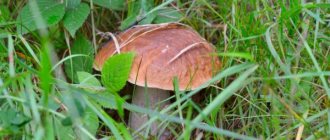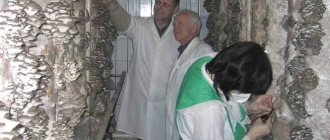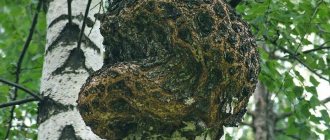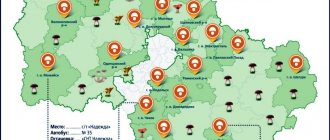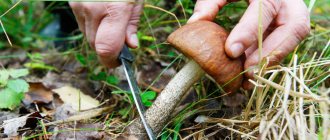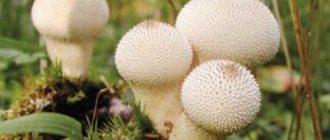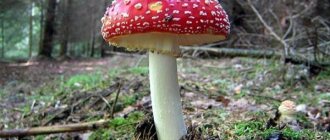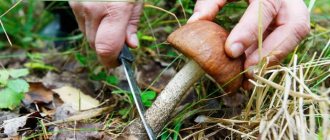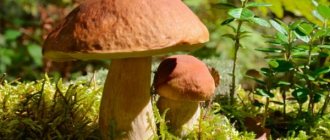We list edible and inedible mushrooms that, in warm weather, can be found in the forest in late spring - early summer.
Traditionally, mushrooms appear around mid-summer, when the ground is already sufficiently warm and moist. But sometimes, at the end of spring, the weather throws up surprises - and you can start collecting forest gifts much earlier. And since this year spring pleased us with warm weather and rains, lovers of “quiet hunting” have already managed to boast of their first mushroom “trophies”. How not to make mistakes when picking mushrooms, and what should you know about it?
Morels
Many gourmets consider morels to be second only to truffles in terms of taste. Nevertheless, in terms of the time of their appearance in the forests, they should be considered unconditionally the first. In good years, the fruiting bodies of morels appear as early as April, delighting the zealous mushroom picker. Who, despite the furious ticks at this time, had already “sharpened his skis” into the forest - as soon as the snow melted there and it became more or less warmer.
It turns out that there are several types of these wonderful mushrooms, but here I will consider only three of them - the most commonly collected. I recommend that the inquisitive reader read the article “Morals - spring mushrooms: about collecting and eating” - it discusses the varieties of these mushrooms that are not included in the text below, and also provides recommendations for collecting, processing, preparing and cooking morels.
Edible morel
Of all the morels, it stands out for its largest size and its abundance. In the baskets of spring gatherers it makes up the lion's share of the total harvest.
Edible morel grows on calcareous soils rich in nutrients, gravitating towards well-lit places, therefore it prefers light forests - birch, aspen, elm, oak groves, poplar groves and pine forests. This mushroom does not avoid mixed forests. In terms of relief, it loves lowlands and floodplains, as well as southern mountain slopes. Usually, edible morels are found where in the forest there are clearings, clearings and gaps among trees, in cluttered places, in old burnt areas. Morels are also found in cities - there they grow in forested areas, as well as in front gardens. Some gardeners can tell you stories about how they found morels right in the garden (in places where fruit trees and shrubs grew), I will say this - there is some truth in these stories.
Appears in our forests around the beginning of May , peaks in growth in the middle to end of this month , continues to release fruiting bodies until June , and then (approximately in the middle of the month) disappears completely. In abnormally warm seasons - when autumn drags on and is dry and sunny - it may appear in October.
Conical morel
The earliest of the morels.
It begins to bear fruit in mid-April , but is not as numerous as its previous brother. Disappears from forests around the end of May , less often - at the beginning of June .
It grows in coniferous and mixed forests, preferring moist grassy places, especially often found in swampy lowlands and floodplains. Also loves cluttered places. It was noticed that the fungus seemed to form mycorrhiza with ash. Unlike the edible morel, it prefers sandy soils.
Morel tall
Externally, this mushroom actually corresponds to the previous one, differing from it only in the darker color of the cap (and even then not always) and a little higher height. In terms of timing of appearance in the forests, it also fully corresponds to its counterpart.
Usually - mid-April - May , less often bears fruit until June .
The growing conditions are almost the same as for the previous morel. Except that the tall morel is periodically found in gardens and vegetable gardens. Well, he still comes across noticeably less often.
Some progressive mycologists consider the conical morel to be a subspecies of the tall morel.
All mushroom reference books say that before cooking, morels should be boiled in salted water for at least 15 minutes and then discard the broth . This is necessary in order to neutralize toxins that may be present in fresh morels.
However, today there is a tendency to challenge this statement by some mushroom pickers who do not boil morels, but cook them immediately. However, do not forget about the statistics of poisoning with fresh morels in Europe and the USA - although this is rare, it still happens. Therefore, we can advise one thing here - for now it is better to boil it “just in case” , and let the learned men deal with the clarification of this topic.
Mushroom picker's lunar calendar for 2021
The mushroom kingdom has never belonged to the world of animals and plants. A separate group, classified as a separate branch of science - mycology, is easy to study as a hobby if a local resident knows firsthand about the distinctive features of edible, poisonous and false subspecies. Knowing the difference and being guided by the phases of the Moon, it will not be difficult to facilitate such tasks as: collection, processing, storage and preparation.
Despite the varieties of families and subspecies, all mushrooms consist of 70-90% water. This means that the lunar phases and their changes directly affect the content of the forest product. According to leading astrologers, active germination of the mycelium begins during the period of growth and stops during the period of decline.
And even though you are collecting, it is recommended that at the time of collection, you prepare for the winter, more correctly in the decline phase. Lovers of quiet hunting have verified from their own experience that pickled and canned recipes, dried and frozen, store much better, provided that the right day is chosen.
The most favorable days for picking mushrooms, drying, freezing and canning for the winter according to the Lunar calendar in 2022
Important! Despite the favorable days of the Lunar calendar provided by astrologers, mushroom collection should be carried out only during the period of precipitation. The best days are considered to be a week from the moment the rains begin. 2-3 days is enough to activate the mycelium in the established month of fruiting.
Unfortunately, a little rain is not enough for mushrooms to germinate well. The more moisture, the more mushrooms can be collected in the forest area. In this case, it does not matter at all whether a small forest belt is chosen for collection or a vast forest area, both deciduous and coniferous, and mixed.
For mushroom picking in 2022, the most favorable phases of the waxing Moon fall during the following periods:
- in April - from 23 to 30;
- in May - from 1 to 6, from 23 to 31;
- in June - from 1 to 4, from 22 to 30;
- in July - from 1 to 4, from 20 to 31;
- in August - 1 and 2, from 19 to 31;
- in September - 1, from 18 to 30;
- in October - 1, from 17 to 31;
- in November - from 16 to 29.
For preparations for the winter, namely: pickling, canning, freezing and drying, the phases of the waning moon in 2021 will be ideal:
- in August - from 4 to 18;
- in September - from 3 to 16;
- in October - from 2 to 15;
- in November - from 1 to 13.
Although the calendar hints can facilitate the collection process, protect your health from mistakes and in case of a small mistake, simple safety rules that imply 3 simple points will allow you:
1) you should not collect mushrooms that are unfamiliar to you or those that raise doubts. The lack of exact characteristics or their absence should alert the mushroom picker, forcing him to pass by the mushroom clearing;
2) you should avoid collecting old mushrooms that have wormy or damaged flesh. Unfortunately, the external ecology does not improve, impregnating the fruits, like a sponge, with toxins, carcinogens and poisons in the adult state. Another thing is young mushrooms that have recently grown in a clearing or forest, distant from factories and other industrial premises, highways, cemeteries and landfills;
3) forests have always been inhabited by snakes and insects that can cause irreparable harm to health. To avoid tick and snake bites, you should not neglect safety rules before going to the forest. Insect repellent sprays combined with clothing that covers the head, legs and torso will help reduce risks to a minimum. A hat, a high-neck jacket, jeans and rubber boots will become an indispensable combination when going on a quiet hunt.
Compared to plants and fruit crops, mushrooms bear fruit quickly. Accelerated growth allows you to collect several buckets at once in one place, observing intervals of one week, adhering to the Lunar calendar. Favorable days, combined with high humidity, will make the harvesting fruitful, capable of producing enough harvest, both for cooking and storing for the winter.
Stitches
Now the most controversial of spring mushrooms will go. Their inconsistency lies in the fact that in Russia, from time immemorial, lines have been devoured by both cheeks, and in the West they are poisoned with them, including with a fatal outcome [1]. kaput"..
The whole point here is the inconsistent concentration of a special toxin contained in the lines. Usually it is such that one or two boils are enough to neutralize the poison. However, sometimes the content of this poison goes off scale, and no amount of boiling helps. Rumor has it that six months of drying can completely get rid of the toxin, but scientists warn that everything here depends on how much poison has accumulated in the fruiting body of the mushroom.
That is, if there is enough of it in the mushroom, no amount of drying or boiling will save you from terrible poisoning.
On top of that, different people’s bodies tolerate string toxin differently. Some people don’t even give a damn about it - there are cases when particularly crazy mushroom pickers ate armfuls of lines in their raw form, and - “at least henna.” But another, more unpleasant statistic is also known - when even a fully processed mushroom with a minute concentration of toxin caused serious poisoning in the eater.
To collect or not to collect lines? This is a voluntary activity of every mushroom picker, but at his own peril and risk .
Nevertheless, we will still consider these spring mushrooms.
By the way, there are actually many more varieties of strings than are described below, and in general a more detailed narrative is devoted to these mushrooms: “String mushrooms: photos, descriptions and something about toxicity.”
Ordinary stitch
It has been noticed that this mushroom prefers coniferous forests to deciduous forests. Loves old burnt areas and clearings, as well as sandy soils.
It bears fruit in late April - early May , and so on almost until June .
The line is gigantic
The largest of the lines. It differs from the previous one in the lighter color of the “hat”. Appears in birch forests and mixed (but always with birch) forests in late April-early May.
It bears fruit until the end of May , less often until the beginning of June .
It grows in well-warmed places - edges, clearings, etc. Like all lines, it feeds on decaying wood dust.
Russula
Now we come to summer mushrooms. First on the list are russulas - as the earliest mass-produced ones. It's funny, but some mushroom pickers don't collect them, considering this a frivolous activity. In vain, because in terms of taste they are quite good (and some types are even considered a delicacy) and have beneficial properties. However, some of the russula are quite pungent in taste when fresh (as a rule, they are distinguished by a provocative bright red color), and the bitterness can irritate the mucous membranes, which can easily cause symptoms of poisoning. But there are quite a few types of edible russula (their distinctive feature is that the pulp is not bitter or pungent, and is often pleasant to the taste), and listing them all would definitely not be enough in one article.
You can read more about edible varieties of russula in the article “Russula (bruises): photo and description.”
Different types of bruises have different periods of appearance. Some of them are early summer, some are late summer, and some are autumn. There are also russulas that bear fruit throughout the warm season.
Therefore, we can safely say that these mushrooms appear in our forests around mid-June , and disappear only in mid-October .
And where they grow - it all depends on the specific species. But in principle, in any forest you can find some edible russula.
Useful applications for mushroom pickers
"Pick mushrooms"
Free application with a convenient intuitive interface. The atlas contains descriptions of several hundred mushrooms with high-quality photographs from different angles. Here there is information about what the mushroom looks like, where it grows, what counterparts it has, and the category of edibility is indicated.
Using this application, the mushroom can be identified in two ways:
- Using the “key to mushrooms”. You fill in the filters with the characteristics of the mushroom you found, and the application gives you options for what it could be.
- Through a smartphone camera. Point it at a mushroom, and the application searches for a similar image in the atlas.
"Mushroom Picker's Guide"
Another application, which, in addition to describing edible and inedible mushrooms, is supplemented with a calendar of when and what mushrooms to collect. It also contains many useful articles that provide answers to most of the pressing questions of mushroom pickers.
"Marinated mushrooms. Recipes"
Download “Marinated mushrooms. Recipes"
In the forest, it is important not to lose anyone and not to get lost yourself. Use the MTS Search application to always understand where your loved ones are.
Butter
Another numerous genus of mushrooms, combining about four dozen different species. A couple of them (dozens) definitely grow in our country.
Boletus, along with russula, are one of the earliest summer mushrooms; moreover, they are known for the fact that they begin to appear together. Their only drawback is increased worminess (up to eight mushrooms per dozen), but nothing can be done about that, because the taste of butter mushrooms has always been excellent.
They grow in different forests, but are more inclined towards conifers. There are especially many butterflies in young, well-warmed pine forests. It is better to collect these mushrooms with cloth gloves, otherwise your hands will be stained with mushroom “snot” and dirt adhering to them.
Butterflies begin to grow in mid-June and continue to appear almost until October . The peak of their fruiting occurs in August-September .
More details about boletus mushrooms are described in the article “Boletus mushrooms: 25 varieties (photos and description).”
Obabki
Despite the fact that boletus mushrooms are usually called obabki, that is, mushrooms with brown caps, according to science it is a whole genus of mushrooms, which includes not only brown boletus mushrooms, but also all kinds of red-headed boletus mushrooms. And what’s most interesting is that there are several types of both. However, the average mushroom picker has never bothered about their diversity, and distinguishes these mushrooms only by the color of their caps. Well, because some of them are found under birches, and some - under aspens.
boletus
Since from time immemorial these mushrooms have been called little girls, we’ll start with them. A brief overview of boletus mushrooms will include the three most commonly collected species; more details about these mushrooms and their other varieties can be read in the article “Boletus mushrooms: what they are, where they grow and when to collect.”
Common boletus
Captured (in all its glory) in the photo above, which headlines the gag section. It is found, of course, in birch forests, or mixed ones, but always with an admixture of birch. It can also grow in the tundra - among dwarf birches, and often has a sprout that is taller than the latter, which is why it is jokingly called “overbirch birch” among tundra inhabitants.
Appears already in June , often in the first half of the month. Continues to bear fruit for quite a long time - until the first half of October . However, everything here depends on the autumn and how early the frosts hit.
Black boletus
It is very similar to the previous species, in fact it is its complete double, differing only in a slightly darker color. But it is better not to use this as a distinctive feature, because both boletus mushrooms are prone to variations in the color of the caps in the dark or light direction. Usually mushroom pickers cannot distinguish between the two at all.
It does not bear fruit for as long as an ordinary boletus, usually from July to September . In October it can hardly be found.
White boletus
And there is one. It has the lightest color of all boletuses, and sometimes it is completely snow-white. It differs from its previous brothers in that it is drawn to damp, wetlands.
White boletuses grow from July to the end of September .
Boletus
They differ from boletus mushrooms in that they form mycorrhiza with aspen. Well, and a brighter color of the hat. The following list will include the three most commonly collected species; more details about these mushrooms and their other varieties can be read in the article “Boletus mushrooms: what they are, where they grow and when to collect.”
Boletus yellow-brown
Probably the most common boletus (and the most beautiful).
Despite its name, it is found not only under aspens, but also under birches, and sometimes in other deciduous forests. It bears fruit from the beginning of June to September ; in warm autumn it can also be found in October .
Red boletus
But this fungus is absolutely indifferent to what tree it grows under. The only “requirement” is that this tree be deciduous. But most often it is found precisely in those forests where aspen grows.
Fruits from June to October . It appears en masse in three “waves”: at the end of June , in mid-July , and also in the second half of August - the first half of September .
White boletus
It turns out that among the boletus mushrooms there is also a light (up to complete whiteness) variety, which, interestingly, is sometimes considered one of the most real porcini mushrooms (unlike the white boletus mushroom discussed recently). Perhaps this is due to the excellent taste characteristics of white boletus.
It’s funny, but this mushroom avoids deciduous forests, preferring to grow among pines and spruces. I have never come across it, although they say that this mushroom is periodically encountered in the Urals.
Collection time is from June to September .
Autumn collection
The mushroom picking schedule in the autumn is no less stressful for keen mushroom pickers and mushroom eaters.
- September: all of the above summer mushrooms appear in the forest again, however, you need to be careful, because It can be difficult to see colorful caps in the bright autumn foliage.
- October: the number of mushrooms is slowly declining and in order to collect a full basket, you need to make a multi-kilometer forced march, like real soldiers. We advise you to look for relatively fresh specimens near stumps or under trees: they retain the heat that the mushroom so needs for a long time.
In October, the mushroom season almost ends
- November: By the beginning of this month the weather becomes cool. And even if you manage to find mushrooms, most likely they will be damaged by frost. These should under no circumstances be used.
In December, the most you can count on is the remains of the autumn harvest and some cold-resistant tree mushrooms.
What mushrooms grow
Autumn is considered the best period for collecting mushrooms precisely because they are filled with useful microelements and vitamins necessary for the body.
The most useful autumn species are considered to be: moss mushrooms, pig mushrooms, milk mushrooms and milk mushrooms, honey mushrooms, porcini mushrooms, devil's fingers, champignons (usually in the fall they are found only in warm regions, for example, in the Krasnodar Territory), trumpet mushrooms, rows and oak mushrooms.
Mokhoviki
The last group of mushrooms that can be considered early summer. Includes several species growing in both coniferous and deciduous forests. Mushrooms usually cluster on moss cushions, which is why they got their name.
They are very similar to boletus, but differ from the latter in having a dry, velvety cap. The taste of the mushrooms is quite good, but for some reason some mushroom pickers do not collect them, considering them mediocre.
They bear fruit from mid-June to September .
How to pick mushrooms correctly
In order for “silent hunting” to bring pleasure and results, you need to follow some simple rules:
- You need to collect mushrooms far from the roadways and industrial enterprises;
- mushrooms grow in families, this must be taken into account when searching;
- It’s better to go mushroom picking early in the morning;
- before going mushroom hunting, you should study all the edible and poisonous mushrooms that may be found in the area;
- do not pick unfamiliar mushrooms;
- choose the right clothes - arms and legs must be covered, have boots and a waterproof raincoat with you;
- You need to collect mushrooms in baskets;
- Have a knife with you to check for larvae and worms in mushrooms;
- don’t forget to take a map of the area;
- It's good to have a cane or stick to move the moss and leaves.
Umbrellas
A very interesting group of mushrooms, among which there are both edible ones - with very high taste qualities, and frankly poisonous species. Unfortunately, due to the strong external similarity, only seasoned mushroom pickers can distinguish good umbrellas from bad ones. I strongly do not recommend that novice mushroom pickers get involved with umbrellas until they have the proper knowledge and experience.
The most recognizable of the edible umbrellas is the variegated umbrella (shown in the photo above). It grows in open areas - meadows, pastures, forest edges. It is distinguished by a darkish cap, covered with variegated scales, and also by the fact that its flesh does not change color when pressed or cut.
They begin to grow in mid-June , appearing in whole groups, and continue to appear until the first half of October .
Chanterelles
One of the few mushrooms that has a very pleasant quality - the complete absence of worms. But in terms of its taste, it is not for everyone, although it is very useful for the body, especially as a good natural anthelmintic.
It grows mainly in birch forests (no matter what anyone says, I have never seen it in other places); according to some information, it can form mycorrhiza with other trees.
For villagers, this mushroom is a good hack. They like to collect it in whole bodies, and then sell it to city residents at a very inflated price. They don’t eat it themselves, they say it’s tasteless.
Chanterelles bear fruit approximately from the end of June to September , but their mass emergence occurs in the first half of July .
More detailed information about chanterelles and their varieties can be found in the article “Chanterelles: varieties, places and times of collection.”
Bitters
I admit, I have seen a lot of these mushrooms in my time, but I have never collected them and, moreover, I have never cooked them. This is how it happened in the Urals - alas, bitter mushrooms are considered the most toadstools. In general, this mushroom is considered second-rate even among its admirers. That is, if they take it, it is only when there is nothing else to collect.
Our Western colleagues, mushroom pickers, agree with us in this regard, and consider bitter mushrooms a generally inedible species. However, according to experts, it is quite possible to eat them - salted or pickled. But first you should soak it.
Bitterweeds grow in coniferous and deciduous forests, and I’ll tell you this - there are a lot of them there (since no one collects them).
These mushrooms bear fruit from late June to October .
I almost forgot! One unpleasant feature has been discovered with bitters - they accumulate radionuclides very well . So, if you live in the Chernobyl protection zone, or somewhere near Chelyabinsk, it is better to refrain from collecting these mushrooms.
About poisonous mushrooms
Some mushrooms look like they should not be eaten. Therefore, be careful when collecting, try to carefully select specimens.
- The pear-shaped puffball can be confused with the hedgehog puffball. The latter should not be eaten under any circumstances.
- The porcini mushroom has many doubles. These include gall and satanic mushrooms.
- An inexperienced mushroom picker risks taking stinking fly agaric or pale toadstool instead of champignon.
- Everyone's favorite boletus and honey mushrooms look like pepper mushrooms.
- Chanterelles are similar to false chanterelles. There are almost no external differences between them. To learn to distinguish these mushrooms, it is not enough to know what they look like in an atlas - you definitely need practical skills.
- Common autumn mushrooms are easily confused with their direct relatives. You should not collect sulfur-yellow and brick-red honey mushrooms in a basket. This can lead to a serious eating disorder.
Champignon
Mushrooms known to many (most from shopping). They love fertile soil rich in organic matter (manure, rotted plant debris, etc.). There are several types of these mushrooms, a couple of which are inedible, and a couple more are poisonous.
They are usually collected in meadows, as well as in gardens and parks. Some species are grown industrially and sold on an equally industrial scale.
Edible mushrooms grow from late June to September .
White
Well, we have finally reached the most important and desired mushrooms - porcini mushrooms.
Where they are found, what forests and what soils they prefer is described in detail in the article “Where porcini mushrooms grow.” Briefly, we can say the following about them. Porcini mushrooms grow in different forests, both coniferous and deciduous, but the most prolific in this regard are dry, well-warmed birch forests, preferably with sandy soil.
They begin to bear fruit at the very end of June , but the most massive appearance of fruiting bodies is observed in July - closer to August . September is the latest time when you can pick porcini mushrooms; in October they disappear.
How to identify a mushroom forest
Experienced mushroom pickers accurately identify a mushroom forest. Mushrooms cannot tolerate either dampness or too much dryness. Swamps, dense thickets, thickets of tall grass, shaded areas, accumulations of dense moss, and heather bushes are also unproductive.
Birch and oak groves, pine forests, mixed forest stands, forests and clearings located on small hills, semi-shaded and sunny areas of forests and ravines are fertile.
The most mushrooms can be collected in the sparse forest on the northern side of the trees, on old abandoned forest mowing roads and paths.
Overgrown clearings also turn out to be fruitful. Mushrooms prefer loose and moist soil. This can be found, oddly enough, in a dry pine forest.
Certain breeds of mushrooms “love” their own, also strictly defined forests. For example, whites grow only in tree stands that are at least 50 years old. It is in vain to look for them in young forests and groves. It will be a waste of time. Porcini mushrooms prefer proximity to the following species of trees and shrubs: oak, hornbeam, spruce, pine, bearberry, heather, lingonberry. They do not shy away from anthills, areas of cleared clearings covered with rotted leaves and pine needles. Of the mushrooms, white mushrooms are most often chosen as neighbors: valui and fly agaric. In hot weather, they should be looked for in sparse ferns and sparse grass, near wet lowlands, where lichens rustle underfoot.
A trip to the forest for mushrooms will be more successful; you will collect more mushrooms if you correctly determine which forest to go to for which mushrooms. To do this, it makes sense to heed the advice of experienced mushroom pickers:
- in the pine forest grow white boletuses, boletuses, valui, volushushki, govorushki, milk mushrooms, chanterelles, moss mushrooms, aspen mushrooms, morels, russula, strings, forest champignons;
- you should go to the aspen forest for boletus, valuya, oyster mushrooms, forest champignons and honey mushrooms;
- in the oak-broad-leaved forest you will find porcini mushrooms and milk mushrooms, oak mushrooms and puffballs, chanterelles and moss mushrooms, morels and honey mushrooms;
- you should go to the alder forest for pink moths, green moss mushrooms, and russula;
- boletus and moss mushrooms grow in deciduous forests.
Volnushki
They are pink waves.
They are found in birch and mixed (with an admixture of birch) forests, preferring places with old trees. They are especially revered by mushroom pickers for their amazing (salted and pickled) taste, despite their conditional edibility (according to some reports, mushrooms are even mildly toxic) and noticeable causticity when fresh. To get rid of it, the mushrooms are especially thoroughly soaked and boiled. The first mushrooms appear at the end of June , but the most massive fruiting of these mushrooms is observed twice during the summer - closer to August and at the beginning of September .
Gobies
Bull mushroom, aka valui. Actually, this is the most ordinary russula, albeit with its own “original” taste and smell characteristics, which do not allow it to be consumed fresh. Usually these mushrooms are collected when they are still young, with the cap not fully opened, and they are salted after preliminary soaking or boiling (otherwise it will be impossible to eat). However, properly prepared valui will outshine other salted mushrooms - this is what gourmets who know a lot about it say. But abroad this mushroom is considered inedible. Well, in vain.
The goby grows everywhere in our forests, preferring both coniferous and deciduous trees. It has been noticed that most of these mushrooms are found in birch forests or mixed forests with an admixture of birch.
Fruits from the beginning of July to the end of September .
Milk mushrooms
Quite a large group of mushrooms, which include not only real milk mushrooms from the genus Mlechnik (that is, those that produce milky juice when cut), but also a couple of representatives of the genus Russula (for example, dry milk mushrooms, which, by the way, is shown in the photo higher).
They all grow in different forests, but they prefer those that have birch (it seems like the most delicious milk mushrooms are found there).
Next, several of the most commonly collected types of milk mushrooms will be considered, but these are not all milk mushrooms that grow on our continent. You can read more about these mushrooms and their varieties in the article “Where milk mushrooms grow: about forests, places and mushroom “habits”.”
Real milk mushroom
He is a raw milk mushroom. “The King of Mushrooms,” the hero of Russian folk tales, has been revered and respected by the people since ancient times. To this day it is considered the best mushroom for pickling. And perhaps no epithets are enough to describe the taste of salted milk mushrooms.
Found in birch forests or forests mixed with birch. Usually found in large groups. Very recognizable by the slightly pubescent edge of the cap (somewhat reminiscent of a giant white cap).
It grows from July to September , most abundantly in August .
Dry milk mushroom
He is also a white loader. Being the most authentic russula, it does not have any caustic milky juice, and therefore it can be cooked without preliminary soaking or boiling. For this quality we are no less revered by mushroom pickers than true milk mushrooms. Dry milk mushrooms are also good for pickling, although it can also be stewed in sour cream, boiled with mycelium, or fried.
It forms mycorrhiza not only with birch, but also with other trees (including conifers), so it is found in a variety of forests. Loves clearings and forest edges.
It grows from July to October , in large numbers in September .
Yellow milk mushroom
It has a slightly yellowish color on the upper part of the cap - with slight variations in the light or dark side. It can be considered a variety of real milk mushroom, because in terms of taste it is actually not inferior to it. We are also revered in our country and in Eastern Europe. But Western Europe clearly underestimated its merits; there the yellow milk mushroom is considered inedible and almost poisonous.
Unlike real milk mushrooms, it gravitates more towards coniferous trees than towards deciduous trees. Often found under spruce trees, less often in pine forests. It can be found even more rarely in a birch forest.
It grows from July to October , in large numbers in late summer and early autumn .
Black milk mushroom
He's a pig. The mushroom is very good in terms of taste, but for some reason some mushroom pickers neglect it. Suitable not only for pickling, but also for stewing or frying - with the obligatory preliminary soaking or boiling.
Just like most milk mushrooms, it breathes unevenly towards birch, so it is found in light birch forests and forests mixed with birch, preferring edges, clearings and other places well warmed by the sun.
It bears fruit from July to October , but most intensively in August-September .
Spruce mushroom
He is also a blue milk mushroom. It is named so because it quickly changes color when cut - from light yellow to purple. Outwardly similar to the yellow milk mushroom, but the color is more intense.
In terms of taste, it is almost at the same level as the real milk mushroom, and by some gourmets it is considered the best mushroom. Used purely for pickles.
Already from the name it is clear that this mushroom is found mainly in spruce forests, although it is often collected in mixed forests.
It begins to grow from the end of August . It bears fruit throughout September - until the first days of October.
Advice from experienced mushroom pickers
Of course, it is useful to know when the new mushroom picking season begins. But this is not enough to get a successful harvest.
Let's try to figure out what containers should be used for gathering, what clothes to choose for a trip to the forest, and how to behave correctly in the wild.
Selecting a collection container
The best container for mushrooms is a wicker basket. Air constantly circulates in it thanks to the small gaps between the branches of the vine, and the fruiting bodies themselves will not be squeezed.
A metal basket is also suitable, but the risk of deformation of the lower layers of mushrooms cannot be ruled out, so it is better to cover the bottom with something.
You should leave plastic bags or plastic buckets at home. In them, the crop has no chance of safe storage.
It is most convenient to put any container in a deep hiking backpack - this makes it easier to transport the crop. In addition, large models even accommodate baskets with a volume of 20 liters.
Selection of clothes
The mushroom picker's equipment depends on the place he is going to. But there are general rules:
You cannot wear suits made of synthetic fabrics, because they will slow down the heat transfer process, which can lead to overheating. The ideal option is a military uniform.
The main criteria for choosing clothes: comfort, durability of the fabric and compliance with weather conditions.
If you don't have a uniform, you should think about choosing simple trousers made of cotton or a mixture of cotton and synthetic materials. On top you should wear a durable windbreaker with a hood.
As for shoes, high-top sneakers or army boots are considered a universal option. Under no circumstances should you go into the forest in sandals, even on a hot day, so as not to become a victim of a bite from a poisonous forest dweller or an accident when, due to such clearly “unforest” shoes, you can end up in a traumatology department.
How not to get lost in the forest
- Before heading out into the forest, tell friends or family about your plans. Firstly, this will give them direction if you get lost, and secondly, you won’t make them worry if you suddenly don’t answer the call.
- Dress brightly to stand out against the trees (or, if you wear regular outerwear, have some kind of bright spot on it). If you are wearing military uniform, tie a bandana or ribbons around yourself.
- Don't go off the path or take shortcuts, even if you're absolutely sure where you're going. This is especially true for novice mushroom pickers, for whom the forest is a “secret with seven seals.”
- Before leaving, repeat the rules of orientation, try to find paper or electronic maps of the reserve or forest, look at them (be sure to take the paper one with you as a supplement to the electronic one in case your mobile Internet “disappears”).
- If you do get lost, try to get to a pond or power lines. Light a fire and wait for the search engines to notice you.
- If possible, do not go into the forest alone, check all your equipment before going out and do not forget to take a knife and matches, as well as those medications that you take regularly.
- Be sure to go out early in the morning: time passes quickly in nature, and in the evening, in the dark, you shouldn’t be far from civilization.
Irina Selyutina (Biologist):
If you do get lost in the forest, it is important to remember: Do not panic: panic has never brought anyone any good. Therefore, you need to follow the sound (railway road, highway). The smell of smoke or manure (from the farm) also helps to get your bearings. When you feel the smell, move against the wind, respectively, towards the source of the odorous substances. If there are no such landmarks, then it is better to go out to the water and go downstream. You can climb the tallest tree and look around. If you find a path, do not rush to rejoice, determine who walks along it - a person or an animal. If branches constantly hit you in the face and chest, get off immediately - this “road” was paved by animals. Set up a place to stay for the night: this is necessary to preserve strength. Try to make a fire, the search engines will see it, and the animals will be careful not to approach. What will we eat: we need to find water or collect it using plastic film. It’s more difficult with nutrition, but try to find edible berries (only familiar ones), nuts, or “sentence” the collected mushrooms - life and health are more valuable. Possible dangers in the forest: wild animals may be interested in you, but even predators attack humans only if they are injured or protecting their cubs. When you encounter an animal, stand still and let it go. Do not turn and run away - this will provoke an attack (you act as the victim). Back away slowly, keeping your eyes on the animal. If there is a wolf or wild boar in front of you, climb a tree. Let yourself be found: to avoid prolonging your search, try to stay in one place, especially if you can light a fire.
To avoid having to search and for your loved ones to worry about your life and health, try to be attentive and careful in the forest.
Belyanki
With white mushrooms, we will begin to look at those mushrooms that appear closer to autumn.
Whiteworts (also known as white moths) grow in birch forests and mixed coniferous-birch forests, and are often found in large groups. They like to hide in the grass and under leaves.
They are good for pickling, although they are not as tasty as true volushki. The acrid taste is eliminated by prolonged soaking and cooking.
They do not bear fruit for as long as other mushrooms - from about mid-August to mid-September , but they appear quite en masse.
Favorable days for collecting, drying and canning mushrooms according to the Lunar calendar 2022
Favorable days of the lunar calendar are distributed at the best time for picking mushrooms, taking into account rainfall.
Attention!
One, even very heavy rain, is not enough for mushroom growth. Rain should thoroughly wet the soil after a dry spell; only subsequent precipitation will provide the necessary nutrition for mushroom growth.
Phases of the waxing moon for mushroom picking in 2022:
- April: 24 – 30
- May: 1-6, 23-31
- June: 1-4, 22-30
- July: 1-4, 21-31
- August: 1-2, 20-31
- September: 1, 18-30
- October: 1, 17-31
- November: 16-29
Saffron milk caps
Saffron milk caps are rightfully considered the best autumn mushrooms. Firstly, for its popularity, and secondly, for its excellent taste (even in Latin, saffron milk cap is called “delicious milkweed”). These mushrooms are especially good when salted.
There are three varieties - the well-known real camelina (in the photo), red camelina and spruce camelina. They are all very similar to each other and differ slightly in appearance. They prefer to grow in coniferous (pine or spruce) forests, especially young forest plantations.
Saffron milk caps begin to appear around mid-August and continue until the very end of September . However, from time to time they can delight the mushroom picker with a short wave in early July .
It turns out that saffron milk cap is not the only mushroom; there are several varieties of it, including some that are quite unusual in appearance. You can read more about these mushrooms in the article “Where saffron milk caps grow: forests, places and times of collection.”
Honey mushrooms
The most common autumn mushrooms, known for their parasitic tendencies.
Mushroom pickers, in principle, love honey mushrooms for their original aroma and taste (these mushrooms are especially good when pickled). However, there are some picky people who consider collecting honey mushrooms a waste of time. Honey mushrooms are found wherever there are trees or shrubs. Their fruiting bodies can be found both on old stumps and on living trees - on trunks and roots. Rumor has it that these fungi can even parasitize herbaceous plants, for example, potatoes.
Honey mushrooms usually grow from the end of August to the end of October - in three layers, but they can give a wave at the beginning of July - under favorable conditions.
There is one type of honey fungus (though it has nothing to do with real honey mushrooms) that can grow at low temperatures. This is the so-called winter honey fungus . You can meet it on trees from autumn to spring. In warm, mild winters it bears fruit all season, but usually appears during thaws. Only experienced mushroom pickers collect it, because this honey mushroom has false poisonous “doubles” that are very similar to it. Abroad, it is cultivated as oyster mushrooms and champignons, where it is known under the Japanese name “ enokitake ”. The cultivated form of the winter honey fungus is very different from the natural one - it has a white color, as well as thin, elongated legs and small caps.
You can read more about the varieties of honey mushrooms in the article: “Honey mushrooms: summer, autumn, winter and others.”
Useful tips and tricks
1) You should not go searching too far from home without knowing the area for sure. The right decision would be to choose a forest located near the city limits. 35-50 km outside the city limits will be quite enough. It is better to take a compass or GPS navigator with you. With their help, it will be easier to get out of the forest when you find a car in a parked area.
2) Options located in contaminated areas should be removed from the list of best places to collect. The list should include places close to industrial facilities, landfills, highways, and cemeteries.
3) Most subspecies of mushrooms germinate in groups. Having discovered one fruit, the mushroom picker should not leave the plot of land. It’s much better to look around.
4) You should avoid mushrooms that cause doubt or mistrust. A basket full of protein products is not worth the loss of health and bad memories.
5) Clothing must be closed, completely covering the head and neck, arms, torso and legs. Such protection will prevent bites from insects and snakes that inject their poison.
The mushroom picker's calendar for 2022 will allow you to find out the most favorable days for collecting and preparing for the winter, as well as approximate periods when it is better to collect mushrooms in order to fill the baskets quickly and to capacity.
greenfinch
The latest mushrooms on our list. They grow in coniferous forests or mixed ones, especially preferring dry pine forests with sandy or sandy loam soil. They are distinguished by their good taste and do not require any processing before cooking, except for thorough washing, since almost all collected greenfinches are always in the ground and sand.
Some gourmets consider these mushrooms especially tasty, but there is a small ambush here: all greenfinches, without exception, contain a small amount of toxins. If you eat them in small and moderate quantities with good breaks, the body (healthy) will cope with these toxins with a bang. However, if you get too carried away with greenfinches, you can get seriously poisoned.
They appear in early September and bear fruit until the first frost (in the south - until November , in the north - until the end of October ). They often grow from under the first snow, which is why they are sometimes called “winter mushrooms.”
Mushroom calendar
And here is the mushroom calendar promised at the very beginning of this article. Let us summarize all of the above in the table below.
Note: the numbers under the abbreviated names of the months indicate their decades. Orange stripes indicate the time of fruiting of the mushroom, and yellow stripes indicate when this occurs en masse.
| Mushrooms | Apr | May | Jun | Jul | Aug | Sep | Oct | ||||||||||||||
| 1 | 2 | 3 | 1 | 2 | 3 | 1 | 2 | 3 | 1 | 2 | 3 | 1 | 2 | 3 | 1 | 2 | 3 | 1 | 2 | 3 | |
| Morels | |||||||||||||||||||||
| Stitches | |||||||||||||||||||||
| Russula | |||||||||||||||||||||
| Butter | |||||||||||||||||||||
| boletus | |||||||||||||||||||||
| Boletus | |||||||||||||||||||||
| Mokhoviki | |||||||||||||||||||||
| Umbrellas | |||||||||||||||||||||
| Chanterelles | |||||||||||||||||||||
| Bitters | |||||||||||||||||||||
| Champignon | |||||||||||||||||||||
| White | |||||||||||||||||||||
| Volnushki | |||||||||||||||||||||
| Gobies | |||||||||||||||||||||
| Milk mushrooms | |||||||||||||||||||||
| Dry milk mushrooms | |||||||||||||||||||||
| Black milk mushrooms | |||||||||||||||||||||
| Yellow milk mushrooms | |||||||||||||||||||||
| Yelnichnye | |||||||||||||||||||||
| Belyanki | |||||||||||||||||||||
| Saffron milk caps | |||||||||||||||||||||
| Honey mushrooms | |||||||||||||||||||||
| greenfinch | |||||||||||||||||||||
Notes[]
Notes
| ↑1 | If you don’t want to, you’ll remember the proverb “what’s good for a Russian is bourgeois kaput.” |
When do the first mushrooms appear?
There is a special mushroom calendar or a mushroom picker’s calendar, which can be used to easily determine in what period which mushrooms grow.
In general, the first specimens appear already in January: if the winter in your region turned out to be warm, oyster mushrooms may be growing already from the first month of the year.
They live on tree trunks. In order not to confuse the mushroom with a poisonous relative, remember the texture of the cap: the oyster mushroom’s cap is leathery and round in shape.
In February, in case of a thaw, the list of mushrooms may be replenished with other species of woody type. But by mid-April, even in not the most fertile places, morels, strings, etc. can be found.
To determine the start of collection, take into account the lunar calendar and recommendations from it, as well as meteorologists’ forecasts for your place of residence and how much the earth has warmed up. This is necessary to know, because... The bulk of the collected mushrooms are mycorrhiza-formers, the life processes of which are very closely related to their symbiont plants.
